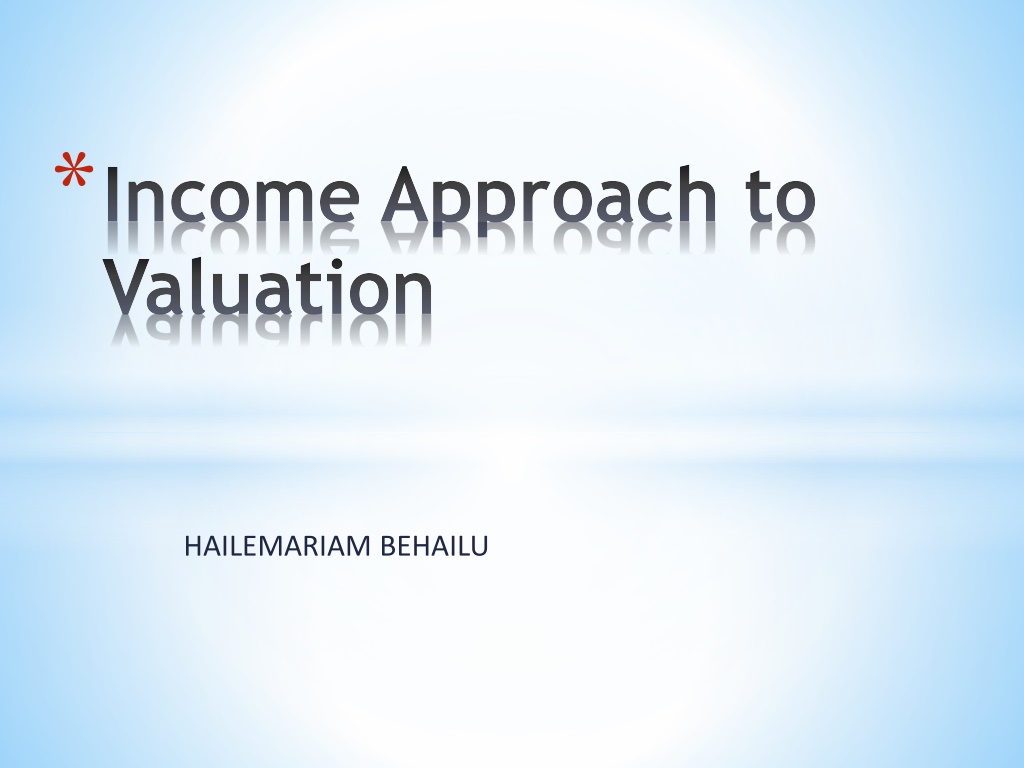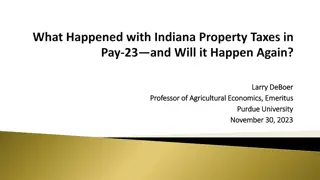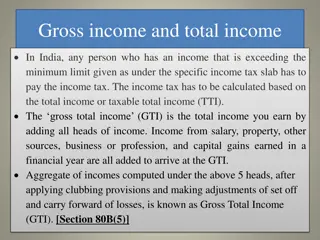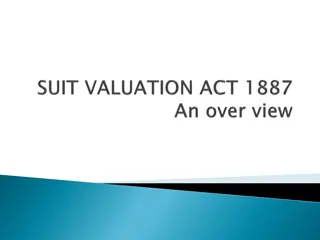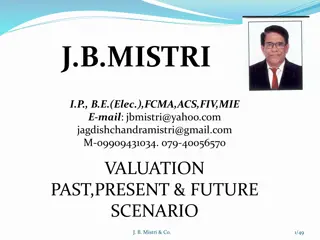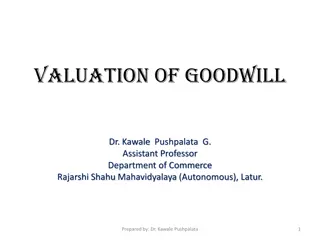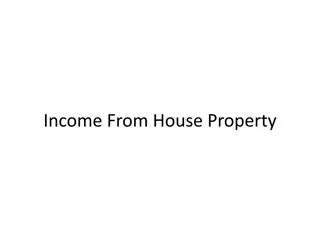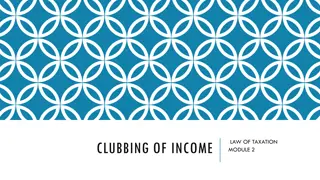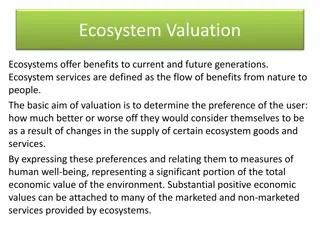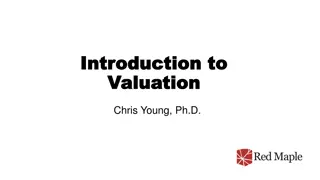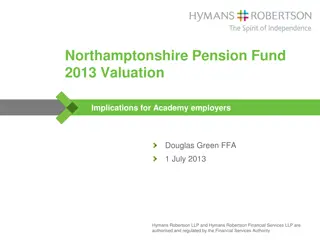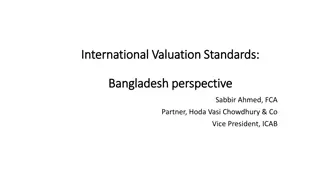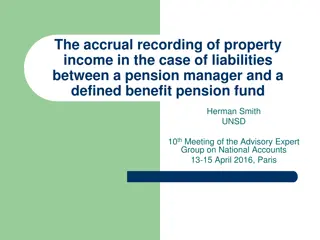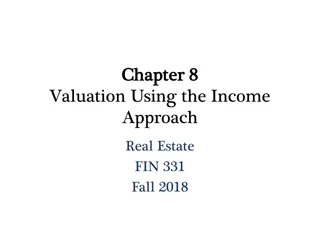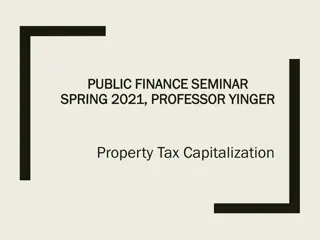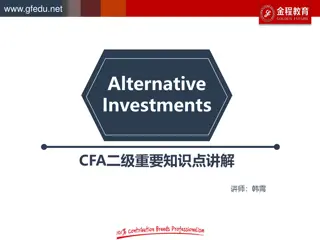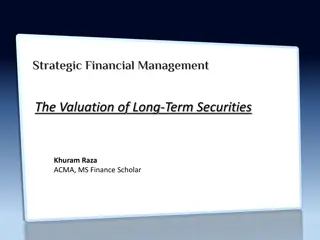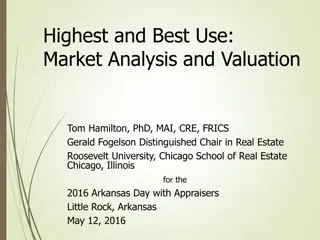Understanding the Income Approach to Property Valuation
The income approach to property valuation involves analyzing a property's capacity to generate future income as an indication of its present value. By considering income streams from rent and potential resale, commercial property owners can convert income forecasts into value estimates through processes like direct capitalization and discounted cash flow valuation. This method provides insights into market value based on income potential and is widely used in property appraisal.
Download Presentation

Please find below an Image/Link to download the presentation.
The content on the website is provided AS IS for your information and personal use only. It may not be sold, licensed, or shared on other websites without obtaining consent from the author. Download presentation by click this link. If you encounter any issues during the download, it is possible that the publisher has removed the file from their server.
E N D
Presentation Transcript
*Income Approach to Valuation HAILEMARIAM BEHAILU
*Valuation Method-income approach *In analyzes a property s capacity to generate *FUTURE BENEFITS INCOME IN TO AN INDICATION OF PRESENT VALUE. *The princciple of anticipation is fundamental to the approach. *All income capitalization procedures attempt to consider benefits and estimate their present value. the income capitalization approach,an appraiser AND CAPITALIZES THE methods,techniques,and anticipated future
*Basis for the income approach *Commercial property owners * Income from rents and price appreciation * Current value thus a function of * Expected income stream * From operating property * From eventual resale * Valuation * Converting income forecast into value estimate (capitalisation of income)
*Processes of income Approach Definitions: *Summarised in 2 steps First step: estimate income Forecast revenue, expenses, resale value * Second step: convert income to value Direct capitalisation DCF valuation (yield capitalisation)
*Direct capitalisation *Values based on ratio & multiple of expected first year NOI *Ratios and multipliers must come from comparable sales *Example: if similar properties are selling for 10 times their 1st year NOI, then subject property will sell for 10 times its expected 1st year NOI *Comparable sold recently 10times its annual NOI *Then the subject property will be valued with respect to its simillar property sold as 10 times its annual NOI it generate !!!!!
*Advantage and problem of DC Advantage * Cap rates and multipliers come from market indications of relationship between income and value, i.e., comparable sales Problem *Using a year s income estimate assumes expected changes in income will be similar for comparables
*Discounted Cash Flow (DCF) *DCF valuation takes the value of an asset to be the present value of the expected cash flows on the asset. *Philosophical basis: Intrinsic value of an asset can be estimated from its characteristics: cash flows, growth and risk. DCF valuation - inputs * A holding period typical of potential investors * Explicit forecasts of cash flows during the life of the asset * Rental rates * Vacancy and collection rates (EGI) *Operating Expenses (NOI) *Cash flow from future selling price of the property *The discount rate to apply to these cash flows to get present value
*Difference between the two methods *The main difference between the two method is described as follows: * Direct capitalisation you do only one year forecast. * DCF valuation you do a multi-year forecast.
*How to reach at NOI ? Potential Gross Income (rent roll) * Potential revenue if property were fully rented out *Two ways to compute PGI: 1. PGI = (Nr of x-room units)*(monthly rent)*(12 2. PGI = (amount of rentable space)*(rent per unit of space) *For expired leases, rent projections must be made Initial rent of subject property usually projected to grow at inflation rate months)
*Contract or market rent? Projections of PGI can be based on Contractual rent terms, or Market rents * If space is covered by existing and long-term leases, revenues are computed from the contractual commitments (assuming financially stable tenants). * Use market rents for any space - not covered by existing leases, or - once existing leases expire. *Market rent = the rental income that space would most likely command on the open market as of the date of appraisal.
*Vacancy and collection losses *Vacancy allowance For properties with short-term leases, * Vacancy can be calculated as a percentage of PGI *Vacancy allowance Explicit forecast for each unit More appropriate for buildings with long-term leases Vacancies arise from time it takes for new tenant to move in, stand- by unit for occupation during repairs etc. *Whatever method you use, check with typical vacancy in local market for similar buildings * Subtracting vacancy allowance from PGI gives the EGI (Effective Gross Income).
*Operating expenses *Regularly occurring expense items associated with current operation of the property Could be fixed, i.e. independent of occupancy levels Could be dependent on occupancy levels and hence variable *Fixed operating expenses: Property taxes * * Hazard Insurance * Property security *Variable operating expenses: * Utilities * Building and grounds maintenance and routine *repairs * Property management (even if owner operated)
*Depreciation *Note: depreciation is not included as an expense Property proforma is a CF statement and not an accrual income statement in the standard accounting sense The occurrence of depreciation shows up anyway in a number of ways: Lower real rents over time Higher operating expenses Higher capital improvement expenses Lower resale value
*Capital expenditures *It is a long term spending aimed at sustained improvement of the physical quality of the property. *Examples: AC system replacements, adding a parking lot, new landscaping etc Tenant improvements an important category of such expenditures in buildings with long leases *Alternate names Replacement reserves, capital and leasing costs etc. replacements, roof
*Net Operating Income (NOI) *Net Operating Income Results from subtracting expenses from all the revenues described earlier Most widely used indicator of net cash flow or operating profit generation ability of an income producing real estate asset
Constructing operating statement Potential Gross Income (PGI) XXXXXX Less vacancy and collection loss (VC) (XXXXX) Plus other income (OI) xxxxx Equals Effective Gross Income (EGI) =XXXXX Less Operating Expenses Fixed expenses Variable expenses Total operating expenses (XXXXX) Less capital improvement expenditure (XXXX) Net operating Income (NOI) =XXXX
Potential Gross income 351,600.00 vacancy and collection loss 17,580.00 Effective Gross Income 334,020.00 Total Operating Expense NOI = ( EGI-TOE) 60,070.00 273,950 PROPERTY VALUE = 273,950.00/9.5% = 2,883,684.21
Capitalization rates and Income Multipliers A capitalization rate is any rate used for the conversion of net income into value. Although there are several types of capitalization rates used in appraisal, they can be classified as either income rates (also known as cash flow rates) or yield rates.
Overall Capitalization Rate (RO) It is an income rate for a total real property interest that reflects the relationship between a single syear s net operating income and the total property price or value; used to convert net operating income into an indication of overall property Overall Capitalization Rate contains return of investment and return on investment. Overall cap rates can be market extracted and compared to other investment opportunities, and can be constructed simply or by using more sophisticated techniques. Overall cap rates reflect risk factors associated with an investment compared to other investment possibilities, and include a rate for recapture of depreciating improvements.
Equity Capitalization Rate (RE) Equity Capitalization Rate is an income rate that reflects the relationship between a single year s cash flow expectancy and the equity investment; used to convert equity dividend into an equity value indication; also called the cash on cash rate, cash flow rate, or equity dividend rate (RE = equity dividend/equity invested. It uses cash flow before taxes instead of operating income. Mortgage Capitalization Rate (RM) Itis capitalization rate for debt; represent ratio of annual debt service to the principal amount of the mortgage.This calculation uses the Annual Debt Service cash flow instead of Operating Income, and the Original Mortgage Principal instead of overall property Value. This calculation explores the relationship between annual debt service payments and the principal amount borrowed. Entry or Going-in Capitalization Rate It is a type of overall capitalization rate assumed or used at time of acquisition of an investment property. As such it is calculated as: Entry Cap Rate = NOI / Acquisition price. Thus, the entry cap rate equals the ratio of the NOI of the property at the time of purchase over the acquisition price. Terminal Capitalization Rate (Reversion Capitalization Rate) The term exit cap rate or terminal cap rate refers to the capitalization rate used to calculate the resale value of a property by capitalizing the expected net operating income of the property at the end of the planned holding period. It shows the relationship between forecasted net operating income at point of disposition and the anticipated sale price for the property. With an exit cap rate forecast at hand, then the property resale price in the last period (n) of the investment horizon can be calculated as: Resale price (n) = NOI (n)/Exit Capitalization Rate.
METHODS OF INCOME CAPITALIZATION The basic formula for direct capitalization (which indicates the relationship between market value and net operating income) is Operating Net Value Market = Income Overall capitaliza tion rate Or in short NOI MV = 0R Where MV is market value, NOI is stabilized net operating income of the next calendar year and 0R is the capitalization rate.
*Direct Capitalization *Process of converting usually first year s income into a value estimate Divide income by an appropriate cap rate Multiply income by a multiplier The basic formulas for direct capitalization are: I =RxV R=I/V V=I/R V=IxF I=V/F F=V/I Where I is Income,R is capitalization rate,V is value ,and F is factor.
Multiplier Formula Implication PGIM Market Potential Gross Income (PGI). Price / Market value = PGI *PGIM EGIM Market Effective Gross Income (EGI). Price / Market value = EGI *EGIM Net Income Ratio =Net Operating Income Effective Gross Income
*Potential Gross Income Multiplier (PGIM) *It is the ratio between the sale price of a property and its potential gross income. PGIM=V/PGI *Where does PGIM come from? Sales data of comparables similar w.r.t Physical, locational and financial attributes basis for calculating rents and expenses * Implied assumption: Future expected annual income will be similar to first year income
*Effective Gross Income Multiplier (EGIM) *It is defiend as the ratio between the sale price (or value) of a property and its effective gross income; a single year s EGI expectancy or annual average expectancies. EGIM=V/EGI *The EGIM is similarly extracted from comparables * Primary difference between PGIM and EGIM is that EGIM is applied to income after allowing for vacancy and credit losses * Advantage with EGI To account for differences in vacancy allowance between subject property and comparable of several years EGI
*Net Income Multiplier (NIM) *It is defined as the ratio between the sales price of a peroperty and the first year s net operating income of the property. NIM =Sales price /NOI1 *NIM extracted from sales data of comparables * Advantage Accounts for differences in expense ratios, vacancy and credit losses * Tradition in appraisal is to use the reciprocal of the NIM, the overall cap rate
Multipliers Two cash flow multipliers may be calculated by potential investors: the net income multiplier and the (effective) gross income multiplier. Net Income Multiplier The net income multiplier, (NIM), is defined as: Pr Acqisition ice NIM = NOI 1 The NIM is, therefore, simply the reciprocal of the cap rate properties with a relatively high cap rate (overall return) sell for a lower multiple of NOI. Gross Income Multiplier (GIM) The gross income multiplier, (GIM) is defined as: ( ) Pr Acquisitio n Asking ice = GIM Grosspoten tialIncome The gross income multiplier is employed more frequently than the net income multiplier; however, it must be used with great care. To compare gross income multipliers, the properties should be equivalent in expense patterns, risk, location, physicalattributes, time, and terms of sale. 37
*Overall capitalization Rate *Cap rate is the reverse of the NIM. Cap Rate=Ro=NOI1/Sales price *Published sources Databases, market reports *Sales prices usually a matter of public record easy to obtain Comparable NOI s not publicly available buyers/sellers source of revenue and expense information Must be adjusted by appraiser * Cap rate is useful in capitalising first year NOI only, not future NOI forecasts and it is not a discount rate.
The formula for deriving an overall capitalization rate from a net income ratio and an effective gross income multiplier is Ro= NOI/EGI=NIR sale vale/EGI = EGIM Example: Suppose a property which was recently sold for 1,125,000 birr has a potential gross income of 180,000 birr and a vacancy and collection loss of 5% of the PGI. Determine the overall capitalization rate based on the EGIM assuming that the operating expense is estimated to be 70,000 birr. To calculate both the denominator and numerator we need to determine Net Operating Income/ Effective Gross Income. Based on the information EGI is equals PGI 5% of PGI = 175,750 (185,000 9,250). NOI is equals to EGI-OE = 105,750 (175,750-70,000). Now, we can calculate Net income ratio (NIR) and Effective Gross Income Multiplier NIM = 105,750 /175,750 = 0.60 and EGIM = sale price/EGI = 1,125,000/175,750 = 6.40 Therefore, overall capitalization rate extracted from the effective gross income multiplier of this property is 9.4%
*Discounted Cash Flow Method *(1) DCF analysis and yield capitalization formulas in greater detail, *(2) yield rate derivation, and *(3) valuation using discounted cash flow analysis and yield capitalization formulas Discounted cash flow tries to work out the value today, based on projections of all of the cash that it could make available to investors in the future. It is described as "discounted" cash flow because of the principle of "time value of money .
*The DCF model is a mathematical model that is used widely in real estate investment analysis and specifically for the estimation of the Present Value (PV) or the Net Present Value (NPV) of cash flows associated with a property investment. * In applying discounted cash flow model, the procedure used to convert these future economic benefits into present value is called discounting,and the required rate of return (or yield rate) is referred to as the discount rate. Discounting is a procedure used to convert periodic income, cash flows, and reversions into present value based on the concept that benefits received in the future are worth less than the same benefits received now.
*The discount rate is the interest rate used for discounting process and may be the property yield rate, equity yield rate or other defined rate. In real estate appraisal practice the most commonly used rate is the property yield rate ( ). * The Overall Yield Rate (YO) The overall yield rate (YO) is perhaps the most commonly used yield rate. It is the required rate of return on total invested capital and is used to discount the annual net income of the entire property and any income derived from the reversion into an indicator of total property value. A yield rate is a rate of return on capital; it is usually expressed as a compound annual percentage rate. A yield rate considers all expected benefits from the property over the income projection period, including both annual net income and any remaining value, or sale proceeds, at the termination of the investment. This remaining value is referred to as the reversion, reversionary interest, or terminal value. When a yield rate is used in yield capitalization to discount future income payments into a value indicator, it is also referred to as a discount rate.
Estimation of Yield Rate * The choice of a yield rate or discount rate is not an easy task in cash-flow analysis. To select an appropriate rate, a valuer must verify and interpret the attitudes and expectations of market participants, including buyers, sellers, advisers, and brokers . *Just as lenders expect to receive back an amount equivalent to the loan amount plus a sufficient rate of return on that amount expressed as interest, *investors in real estate expect to receive back what they pay for an investment plus a sufficient return on it, which is represented by the yield rate ordiscount rate. *The present worth of the cash flows, discounted at the yield rate, results in the amount the investor can afford to pay for the investment (its value) if that yield is to be achieved. *Thus, it is very important to determine an appropriate yield rate in yield capitalization method to discount the future value into present value
*The estimation of yield rates for discounting cash flows should focus on the prospective or forecast yield rates anticipated by typical buyers and sellers of comparable investments. *An appraiser can verify investor expectations directly, by interviewing the parties to comparable sales transactions, or indirectly, by estimating the income expectancy and likely reversion for a comparable property and deriving a prospective yield rate. The assessment of the discount rate is done based on general economic conditions combined with specific property market conditions (Deriving the IRR from analysis of market transactions of similar properties having comparable income patterns is a proper method for developing market discount rates for use in valuations to arrive at a market value (IVSC, 2003). The interest rate is computed as follows:
*Discount rate = Real interest rate on risk-free assets + Inflation + Risk factor (market risk) Or *Discount rate = Nominal interest rate for risk- free asset + Risk factor *The mathematical formula for the discount rate is based on Fischer s formula: *Nominal discount rate = (1 + Real interest rate for risk-free asset) x (1 + Inflation) x (1 + Risk)
*The required return comprises two parts, known as the risk- free rate and the risk premium. The former is common to most investments, and the latter varies depending on the investment risk. The nominal required return formula is shown below: * *RN = RFN + RP * *Where, RN = nominal required return, RFN = nominal risk-free rate and RP = risk premium
*REVERSION *Income producing properties can generate two types of financial benefits: periodic income and resale value. *cash flows streams is not only limited to periodic income obtained from the operation of the property but also the value obtained from the sale of the property or reversion of the property at the end of the holding period. These are the Reversion is the resale value of the property. *For investors, it is the last cash flow they get from the sale of the property. *In the sale the invested capital reverts back to the owner. Thus, the proceeds from the sale are frequently referred to as reversion.
*The best, most widely used method for forecasting resale value is direct capitalisation of NOI at the end of the holding period. *For Example, for a 10-year DCF, project NOI for 11th year divide by an assumed resale cap rate. In discounted cash flow (DCF) analysis, an appraiser can discount each payment of income and reversion separately and add all the present values together to get the present value of the property being appraised. *One of the well practiced model that used to estimate a terminal value is to value the property as a perpetuity using the Gordon Growth Model. The model uses this formula: Where SV = Salvage value; NOI n+1 = net operating income of nth + 1 period. e.g if DCF is calculated for 10 year it means income of 11th year) , r is discount rate (terminal/ reversion capitalization rate or exit yield) and g is growth of income and n = number of periods in the projection
*The capitalization rate used to estimate the resale price is referred to as terminal reversion capitalization rate or exit yield. *It is different from the overall capitalization rate used in the direct capitalization method. The term exit cap rate or terminal cap rate refers to the capitalization rate used to calculate the resale value of a property by capitalizing the expected net operating income of the property at the end of the planned holding period. *It shows the relationship between forecasted net operating income at point of disposition and the anticipated sale price for the property
*Resale value, thus, dependent on and sensitive to exit yield. Conceptually exit yield should be slightly more than or equal to initial yield. This situation reflects the assumption that the income producing ability of the property (i.e. their productivity) will decline over time. As buildings age, they become more risky or less able to generate rent or more in need of capital improvement expenditures. *So exit yields of older buildings would be higher than that of similar newer buildings * Example: Using the table below, if we have a holding period of 5 years, and the terminal cap rate is 10%, what is the salvage value? The cash flow of the last projected year will stabilize and continue at the same rate for ever.
Year (holding period) 1 2 3 4 5 6 NOI 100,000 103,000 106,090 109,273 112,551 112,551 Solution: the salvage value is calculated by using the formula Since g=0, the sixth year NOI divided by terminal cap rate represents the salvage value of the property. SV= 112,551/10% = 1,125,510 and The discounted salvage value is 698,853.16 (1,125,510/ (1+0.1) ^5.
*Discounted Cash Flow DCF Process *Generating a reconstructed operating statement for the asset *Typical holding period is 10 years *More practical to do 5-year forecasts * Cash flow forecasting more difficult than it seems You need experienced hands to guide you in developing good assumptions Reversion Cash flows *Second major part of eventual part of property value In a typical 10-year DCF valuation, salvage value accounts for over a third of property value!!!
*Continued........ Salvage Value *The best, most widely used method for forecasting resale value Direct capitalisation of NOI at the end of the holding period Example: for a 10-year DCF, project NOI for 11th year Divide by an assumed resale cap rate Gordon formula quite common in determining exit yield
ESTIMATING THE SALVAGE VALUE We can use a cap rate at the end of the holding period to capitalize the first year NOI to the next owner. This cap rate is known as the terminal cap rate or exit yield
Pro Forma Operating Statement which takes in to account the debt Pro Forma Operating Statement which takes in to account the debt service and income taxes service and income taxes. Potential Gross Income (PGI) -Vacancy Loss & Collection Loss (VLC) + other income (OI) =Effective Gross Income (EGI) - Operating Expense (OE) =Net Operating Income (NOI) -Debt service (DS) =Before tax cash flow(BTCF) -Income Tax (IT) =After tax cash flow (ATCF) 46
Estimating Cashflows 1. Revenues - Operating expenses = Earnings before interest, taxes, depreciation, and amortization. (EBITDA) 2. EBITDA - Depreciation and Amortization = Earnings before interest and taxes (EBIT) 3. EBIT - Interest Expenses = Earnings before taxes 4. Earnings before taxes Taxes = Net Income 5. Net Income + Depreciation and Amortization = Cash flow from Operations 6. Cash flow from operations - Working Capital change - Capital spending - Principal Repayments + Proceeds from New Debt Issues = Free Cash flow to Equity.
Advantages of DCF Valuation *Since DCF valuation is based upon an asset s fundamentals, it should be less exposed to market moods and perceptions. *If good investors buy businesses, rather than stocks (the Warren Buffett adage), discounted cash flow valuation is the right way to think about what you are getting when you buy an asset. 48
Disadvantages of DCF Valuation *Since it is an attempt to estimate intrinsic value, it requires far more inputs and information than other valuation approaches *These inputs and information are not only noisy (and difficult to estimate), but can be manipulated by the savvy analyst to provide the conclusion he or she wants. 49
